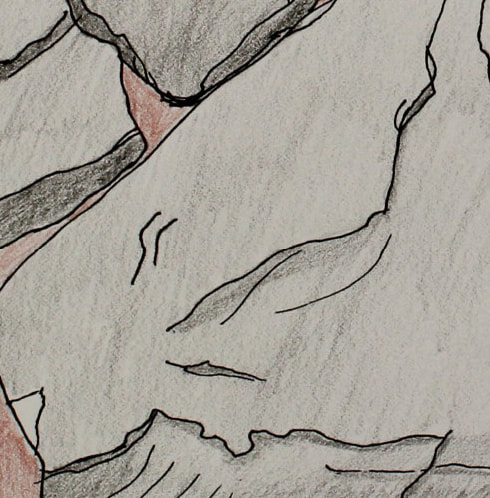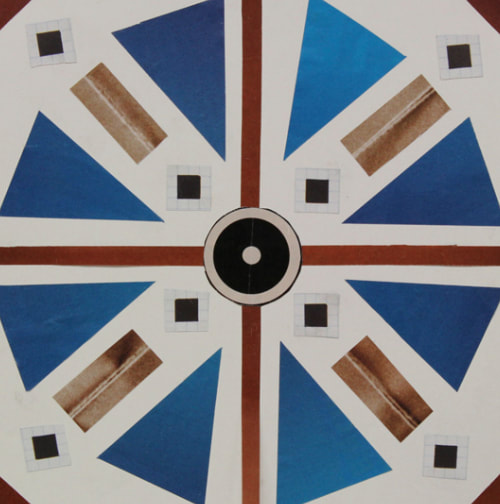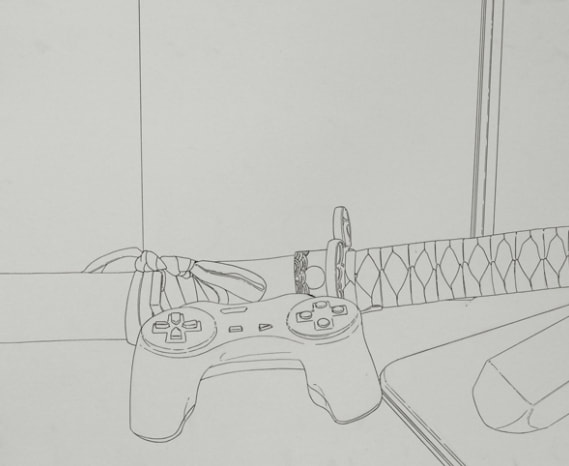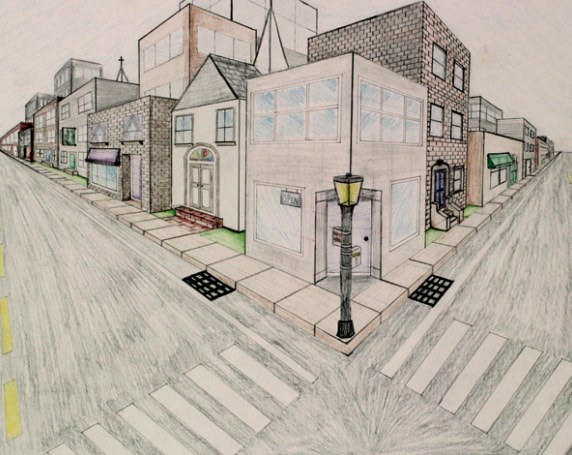Fundamentals of Art & Design
Frederick Community College, Frederick MD (2012-2013)
Course Objectives
Students will develop skills in using different drawing mediums and approaches. This course emphasizes learning how to draw still life, landscape, drapery studies and experimental problems. Includes problems of scale and collage. Students will acquire a portfolio of drawings from studio work. Students must furnish supplies.
Core Learning Outcomes
Instructional Methods
Progress Reports
Students will receive some form of written assessment of their progress in the course no later than the seventh week of the semester.
Grading
Quizzes: 40%
Museum Visit Write-up: 10%
Projects: 40%
Participation: 10%
Extensions may be possible with prior conversations with me regarding your situation.
Any project accepted will not receive full credit and will be graded at my discretion.
Participation Policy
Participation: To maintain the highest quality of academic work, the course level class participation policy encourages and expects the student to participate fully in all course activities. In case of serious illness, emergency, religious holidays, or participation in official college functions, students remain responsible for completing the requirements of the course. A letter grade will be deducted from the student's final grade due to non- participation in each class missed beyond three (3).
Satisfactory Participation:
Cell Phones
Please turn off all phones while in the studio.
Extra Credit
Students may receive additional credit for attending an art event or local exhibition, lecture or art demonstration. Students must write a two-page critique of the event. See instructor for specific outline. One (1) extra credit project per student. Deadline for all extra credit is 2 weeks prior to last class.
Required Text
Art Fundamentals, Theory and Practice: Ocvik, Bone, Stitson, Wigg
(New: $108 Used $81 RENT FROM BOOK STORE: $37)
Museum Visit Requirements
The student is asked to visit an Art Gallery or Museum, select a work of art and address the following questions. In the introduction of the written narrative, the student is to identify and briefly describe the location, and to include a copy of the image which is being critiqued and a postcard of the organization. The student may find the image in an Art History Text, on the Web or take a digital photograph of the image. The Student must provide the post card evidence of their on site visit. The written narrative will be at least 2 typed pages when completed.
Describe:
Academic Integrity
Students are required to uphold the Code of Academic Integrity and the Code of Student Conduct. Students who violate either of these codes may receive a failing grade in the class. Information about these codes and other student policies, procedures, and penalties is available on the Student Policies and Procedures web page.
Included among dishonest behaviors in an academic setting are cheating (using or attempting to use unauthorized assistance, materials, information, or study aids in an academic exercise), fabrication (falsifying or inventing information in an academic exercise), plagiarism(adopting or reproduction of ideas, words, or statements of another person without appropriate acknowledgment), interference (stealing, changing, destroying, or impeding another students work), and facilitating (intentionally or knowingly helping or attempting to help another student commit an act of academic misconduct.
Students with Disabilities
Students with disabilities who are in need of accommodations or who have questions related to disabilities services should contact the Services for Students with Disabilities (SSD) office at 301-846-2408. Students can learn more about these services by visiting the Services for Students with Disabilities web page.
Course Calendar
Week 1: Balance and Symmetry
Project: Balance and Symmetry
In Class:
Introductions
Critique Homework 1
Hand out and go over syllabus
Lecture: Elements of Art, Balance and Composition
Week 2: Form and Figure/Ground Relationships
Project: Figure/Ground Relationships
In Class:
Chapter 1 Quiz: Individual
Critique Project 1
Lecture: Figure/Ground Relationships
Lecture: Form
Chapter 1 Quiz: Partners
Week 3: Line
Project 3: Line
In Class:
Chapter 2 Quiz: Individual
Critique Project 2
Lecture: Line
Chapter 2 Quiz: Partners
Week 4: Shape
Project 4: Line and Shape in Narrative Storyboarding
In Class:
Chapter 3 Quiz: Individual
Critique Project 3
Lecture: Lecture: Shape
Chapter 3 Quiz: Partners
Week 5: Value
Project 5: Value in Charcoal Drawing
In Class:
Chapter 4 Quiz: Individual
Critique Project 4
Lecture: Value
Chapter 4 Quiz: Partners
Charcoal Drawing: Demo and Instructions
Week 6: Value (continued)
In Class:
Continue Project 5
Film
Homework:
Week 7: Texture
Project: Texture Drawing
In Class:
Chapter 5 Quiz: Individual
Critique Project 5
Lecture: Texture
Chapter 5 Quiz: Partners
Graphite drawing of in-class still life
Week 8: Break
Week 9: Color
Project: Color Relationships
In Class:
Chapter 6 Quiz: Individual
Critique Project 6
Lecture: Color
Chapter 6 Quiz: Partners
Color Mixing
Museum Visit Assignment Due
5 Color Scheme Grids: 1 Monochromatic, 1 Complimentary, 1 Analogous, 1 Tertiary color, 1 Warm or Cool colors
Week 10: Color (continued)
In Class:
Critique Project 7
Work on Color Still Life
Enhance texture details, embellish lines, give dramatic value using paint and color
Homework:
Week 11: Space
Project: Architectural Perspective Drawings
In Class:
Chapter 7 Quiz: Individual
Lecture: Space
Chapter 7 Quiz: Partners
Perspective Project Examples
Week 12: Space (continued)
In Class:
Work on Perspective Drawings
Enhance texture details, embellish lines, give dramatic value
Add color as accents to your detailed
Watch film while workingHomework:
Week 13: Time and Motion
Project: Flipbooks
In Class:
Chapter 9 Quiz: Individual
Critique Project 8
Lecture: Time and Motion
Chapter 9 Quiz: Partners
Flipbook Project Instructions
Week 14: Art History Review
In Class:
Week 15: Final Projects
In Class:
Work on Final Project
Film
Homework: Finish Final Project
Week 16: Final Critiques
Grading Criteria
A: OUTSTANDING WORK!
Demonstrates a comprehensive understanding of concepts and techniques presented shows exceptional attention to detail and excellent craftswo/manship demonstrates outstanding creativity and initiative
B: GOOD JOB! YOU ARE ON THE RIGHT TRACK.
Demonstrates a good understanding concepts and techniques presented shows attention to detail and commendable craftswo/manship demonstrates creativity and initiative.
C: YOU ARE DOING OK, BUT COULD BE DOING BETTER. ASK FOR HELP.
Demonstrates a base level understanding of concepts and techniques presented shows little attention to detail and lacking in craftswo/manship lacking in creativity and initiative.
D: POORLY EXECUTED.
Demonstrates no understanding of concepts and techniques presented shows no attention to detail and deficient craftswo/manship demonstrates no creativity or initiative.
F: NOT EXECUTED OR FRAUDULENT SUBMISSION.
Student does not attempt the course activity or submits a project which shows evidence of plagiarism, fraud, or copyright violation.
Examples of Student Work:
Students will develop skills in using different drawing mediums and approaches. This course emphasizes learning how to draw still life, landscape, drapery studies and experimental problems. Includes problems of scale and collage. Students will acquire a portfolio of drawings from studio work. Students must furnish supplies.
Core Learning Outcomes
- Demonstrate college-level communication skill:Students will demonstrate the ability to understand and interpret both written and oral presentations in English. Students will continue to develop and enhance their communication skills through the visual language of drawing.
- Demonstrate critical thinking skills: Students will demonstrate a disposition toward critical thinking in their choices of media, subject and technical approach to drawing. Students will solve a series of conceptual and observational assignments using creative thinking and originality.
- Students will display general knowledge and historical awareness: Students will demonstrate a knowledge of and appreciation for American culture as expressed in the visual arts. Students will continue to use a variety of materials and media that visual artists throughout history have used to execute their work.
- Students will understand and be able to interpret social and educational values: Students will value the importance and responsibility of the individual. Students will demonstrate an ability to analyze, compare, and critique drawings that they, their peers and other artists have created.
- Students will be able to make informed critical responses to the arts and to the human values expressed in all art forms: Students will demonstrate an awareness of the visual arts as both a record and a reflection of our culture. Students will recognize that the visual arts provide opportunities for self-expression and personal growth.
Instructional Methods
- Lecture/discussion with audiovisual material (slides/videos/CDs).
- Readings from recommended texts and other suggested sources.
- Students produce drawings that interpret and expand upon the ideas and assignments introduced by the instructor.
- Individual and group critiques serve to analyze the work produced and enhance the student's understanding of the concepts and physical skills that constitute each drawing assignment
Progress Reports
Students will receive some form of written assessment of their progress in the course no later than the seventh week of the semester.
Grading
Quizzes: 40%
Museum Visit Write-up: 10%
Projects: 40%
Participation: 10%
Extensions may be possible with prior conversations with me regarding your situation.
Any project accepted will not receive full credit and will be graded at my discretion.
Participation Policy
Participation: To maintain the highest quality of academic work, the course level class participation policy encourages and expects the student to participate fully in all course activities. In case of serious illness, emergency, religious holidays, or participation in official college functions, students remain responsible for completing the requirements of the course. A letter grade will be deducted from the student's final grade due to non- participation in each class missed beyond three (3).
Satisfactory Participation:
- Present at start time of the class
- Attending class for the entire duration of the class
- Bringing all supplies and reference materials to class
- Actively working on projects to completion
- Taking notes
- Listening attentively and silently to presentations and explanations
- Participating in activities assigned by the instructor
- Voluntarily participation in class critiques and discussions
- Working in groups as assigned by the instructor
Cell Phones
Please turn off all phones while in the studio.
Extra Credit
Students may receive additional credit for attending an art event or local exhibition, lecture or art demonstration. Students must write a two-page critique of the event. See instructor for specific outline. One (1) extra credit project per student. Deadline for all extra credit is 2 weeks prior to last class.
- Drawing Pad, 19 X 24" (Bristol)
- 3"x5" Blank (NOT lined) White Index Cards
- 18" metal ruler
- Xacto knife
- Scissors
- Cutting mat
- Glue stick
- Fine and xtra fine sharpies
- Pentalic Woodless Pencils, Grumbacher – 2B, 4B, 6B, and 8B (1 – 2 each)
- Venus or Staedtler Pencils – 4H, 2H, HB, 2B, 4B, 6B (an 8 if you come across them) (1 – 2 each)
- Colored Pencils
- Pencil Sharpener
- Multi Colored Construction Paper
- Red, Yellow and Blue Acrylic Paint
- Kneaded Eraser
- Pink Pearl Eraser
- Blending Tools: Tortillons (a.k.a. paper stumps), paper towels, chamois cloth, Q- tips
- Masking Tape
- Charcoal – soft or extra soft
- Color Wheel
- Portfolio case
Required Text
Art Fundamentals, Theory and Practice: Ocvik, Bone, Stitson, Wigg
(New: $108 Used $81 RENT FROM BOOK STORE: $37)
Museum Visit Requirements
The student is asked to visit an Art Gallery or Museum, select a work of art and address the following questions. In the introduction of the written narrative, the student is to identify and briefly describe the location, and to include a copy of the image which is being critiqued and a postcard of the organization. The student may find the image in an Art History Text, on the Web or take a digital photograph of the image. The Student must provide the post card evidence of their on site visit. The written narrative will be at least 2 typed pages when completed.
Describe:
- The presentation & context of the work(s) of art using the appropriate arts vocabulary
- The elements of the work of art
- The emotional value of a work of art
- The artist's intent
- The creative quality of the work of art
- The execution of the work of art
- The personal impact of the work of art
- The link between the work of art & the human condition
Academic Integrity
Students are required to uphold the Code of Academic Integrity and the Code of Student Conduct. Students who violate either of these codes may receive a failing grade in the class. Information about these codes and other student policies, procedures, and penalties is available on the Student Policies and Procedures web page.
Included among dishonest behaviors in an academic setting are cheating (using or attempting to use unauthorized assistance, materials, information, or study aids in an academic exercise), fabrication (falsifying or inventing information in an academic exercise), plagiarism(adopting or reproduction of ideas, words, or statements of another person without appropriate acknowledgment), interference (stealing, changing, destroying, or impeding another students work), and facilitating (intentionally or knowingly helping or attempting to help another student commit an act of academic misconduct.
Students with Disabilities
Students with disabilities who are in need of accommodations or who have questions related to disabilities services should contact the Services for Students with Disabilities (SSD) office at 301-846-2408. Students can learn more about these services by visiting the Services for Students with Disabilities web page.
Course Calendar
Week 1: Balance and Symmetry
Project: Balance and Symmetry
In Class:
Introductions
Critique Homework 1
Hand out and go over syllabus
Lecture: Elements of Art, Balance and Composition
- 3 Total: 1 PERFECT Symmetry, 1 Asymmetrical, 1 Radial Symmetry
- 14"x14" square for each
- Don't use any magazine cut out LARGER than 3" in any direction
- Don't leave ANY white space on the paper
- Buy materials
- Finish Collages
Week 2: Form and Figure/Ground Relationships
Project: Figure/Ground Relationships
In Class:
Chapter 1 Quiz: Individual
Critique Project 1
Lecture: Figure/Ground Relationships
Lecture: Form
Chapter 1 Quiz: Partners
- Using various shapes, make 3 examples of ambiguous figure/ground relationships
- Use sharpie on paper
- 14"x14" square
- Use shapes that are no more than 5" in any direction
- Draw out in pencil first, then add sharpie
- DO THEM QUICKLY ENOUGH TO TALK ABOUT THEM BEFORE GOING HOME
- Find 3 photographs: 1 portrait of someone, 1 landscape, 1 detail shot of something
- Identify what the FIGURE is in each and outline
- Identify the GROUND in each (what is left after outlining the FIGURE)
- On a 19"x24" piece of paper, draw a 1" border around the drawing area
- Draw a single outline of the shape that is the FIGURE in your photograph inside your area, separating it from its GROUND
- Using one dark color, nearly black but not black, and one light color, white, but not white, decide whether to darken the FIGURE or the GROUND
- DO THIS FOR EACH PHOTOGRAPH
- Keep your borders sharp and clean
- Make clean edges between shapes
- Keep your color quality even
- Use marker evenly – no streaky lines!!
- BRING YOUR ORIGINAL PHOTOS INTO CLASS TOO
Week 3: Line
Project 3: Line
In Class:
Chapter 2 Quiz: Individual
Critique Project 2
Lecture: Line
Chapter 2 Quiz: Partners
- 7 blind contour drawings (20 secs): 3 of whole set-up, 4 of four different shapes
- Timed line drawings (30 seconds to 10 minutes): looking at paper and still life
- Use graphite first, then Sharpie
- 2 hours working on contour drawing
- Beginning with pencil and outlining in sharpie with at least 3 different line weights
- FILL ENTIRE PAGE
- ALL FOUCUSING ON ONLY CONTOUR LINES and ACCENT LINES: NO SHADING TECHNIQUES
- Use only line to dramatically embellish your in-class drawing
Week 4: Shape
Project 4: Line and Shape in Narrative Storyboarding
In Class:
Chapter 3 Quiz: Individual
Critique Project 3
Lecture: Lecture: Shape
Chapter 3 Quiz: Partners
- Make up a very short story about an incident or event with a simple beginning, middle and end
- Draw five squares, 4.5" in width and height; Each square should share an edge with the next (22 inches in total width)
- Keep a .75" border between the edge of your paper on all sides (this should fit the width of your paper)
- In the first square, use line and shape to draw the initial setting of your story and any characters it might have
- In the second square, draw the build up to the middle of the story using line and shape
- In the third square, draw the climax of your story (the main event)
- In the fourth square, draw the events leading up to the end of your story
- In the last square, draw how your story ends
- Use various shapes to create the setting of your story and the characters of your story
- Use line work to create a mood and depth for each of your squares
- Finish Project 4
Week 5: Value
Project 5: Value in Charcoal Drawing
In Class:
Chapter 4 Quiz: Individual
Critique Project 4
Lecture: Value
Chapter 4 Quiz: Partners
Charcoal Drawing: Demo and Instructions
- Charcoal drawing on in class still life
- Pay attention to the contrast you are developing
- Keep your darks dark and your lights light
- Fill your entire page and leave no white space
- Charcoal drawing on at home still life
- Pay attention to the contrast you are developing
- Keep your darks dark and your lights light
- Fill your entire page and leave no white space
Week 6: Value (continued)
In Class:
Continue Project 5
Film
Homework:
- Charcoal drawing on at home still life
- Pay attention to the contrast you are developing
- Keep your darks dark and your lights light
- Fill your entire page and leave no white space
Week 7: Texture
Project: Texture Drawing
In Class:
Chapter 5 Quiz: Individual
Critique Project 5
Lecture: Texture
Chapter 5 Quiz: Partners
Graphite drawing of in-class still life
- 5"x5" square
- VERY detailed
- Fill your entire square and leave no white space
- Draw 9 4" x 4" squares, 1" apart, 1" border around all, 3 across, 3 down
- Use hard graphite for your first light drawings, then use harder graphite when needed for emphasis
- Find three different examples of wood texture and draw a detailed drawing of one in each of the first three squares
- Find three different examples of rock texture and draw a detailed drawing of one in each of the second three squares
- Find three different examples of water texture and draw a detailed drawing of one in each of the third three squares
Week 8: Break
Week 9: Color
Project: Color Relationships
In Class:
Chapter 6 Quiz: Individual
Critique Project 6
Lecture: Color
Chapter 6 Quiz: Partners
Color Mixing
Museum Visit Assignment Due
5 Color Scheme Grids: 1 Monochromatic, 1 Complimentary, 1 Analogous, 1 Tertiary color, 1 Warm or Cool colors
- Use at least 1 tint and 1 shade of each color as well
- Draw grids in class
- Mix your colors from Red, Yellow and Blue
- Fill your entire square and leave no white space
- Work on Color Grids at home
Week 10: Color (continued)
In Class:
Critique Project 7
Work on Color Still Life
Enhance texture details, embellish lines, give dramatic value using paint and color
Homework:
- Work on Color Grids at home
Week 11: Space
Project: Architectural Perspective Drawings
In Class:
Chapter 7 Quiz: Individual
Lecture: Space
Chapter 7 Quiz: Partners
Perspective Project Examples
- Use the image of a street corner provided to practice drawing two point perspective
- Draw your intersecting streets fading into your two vanishing points
- Fit the buildings into the space within your vanishing points
- Draw a 1" border around the inside of your paper
- Use your hard graphite pencil to start
- Use line and shading in graphite to add details
- Work on Perspective Drawings at home
Week 12: Space (continued)
In Class:
Work on Perspective Drawings
Enhance texture details, embellish lines, give dramatic value
Add color as accents to your detailed
Watch film while workingHomework:
- Work on Perspective Drawings at home
- BRING IN INDEX CARDS FOR NEXT WEEK
Week 13: Time and Motion
Project: Flipbooks
In Class:
Chapter 9 Quiz: Individual
Critique Project 8
Lecture: Time and Motion
Chapter 9 Quiz: Partners
Flipbook Project Instructions
- Use your hard graphite pencil to start
- Use line and shading in graphite to add details
- Work on Flipbooks at home
Week 14: Art History Review
In Class:
- Lecture: Art History Review
- Critique Project 9
- Lecture: Art History Review
- Film: Cave of Forgotten Dreams
- The subject is up to you
- Must use line, value, texture, a deliberate color scheme of mixed colors from red, yellow and blue
- Must employ one or two point perspective and some evidence of the passage of time
Week 15: Final Projects
In Class:
Work on Final Project
Film
Homework: Finish Final Project
Week 16: Final Critiques
Grading Criteria
A: OUTSTANDING WORK!
Demonstrates a comprehensive understanding of concepts and techniques presented shows exceptional attention to detail and excellent craftswo/manship demonstrates outstanding creativity and initiative
B: GOOD JOB! YOU ARE ON THE RIGHT TRACK.
Demonstrates a good understanding concepts and techniques presented shows attention to detail and commendable craftswo/manship demonstrates creativity and initiative.
C: YOU ARE DOING OK, BUT COULD BE DOING BETTER. ASK FOR HELP.
Demonstrates a base level understanding of concepts and techniques presented shows little attention to detail and lacking in craftswo/manship lacking in creativity and initiative.
D: POORLY EXECUTED.
Demonstrates no understanding of concepts and techniques presented shows no attention to detail and deficient craftswo/manship demonstrates no creativity or initiative.
F: NOT EXECUTED OR FRAUDULENT SUBMISSION.
Student does not attempt the course activity or submits a project which shows evidence of plagiarism, fraud, or copyright violation.
Examples of Student Work:




